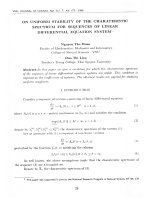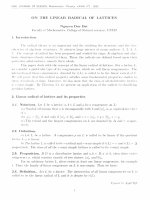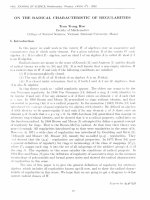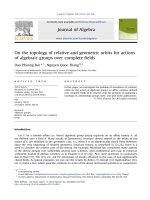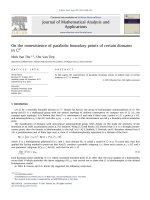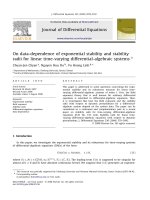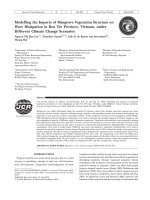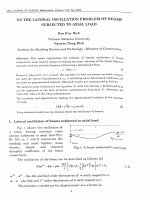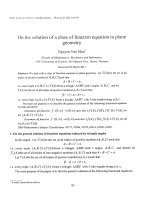DSpace at VNU: On the structure of legal norms and relationship between behavioural and decisive legal norms
Bạn đang xem bản rút gọn của tài liệu. Xem và tải ngay bản đầy đủ của tài liệu tại đây (2.7 MB, 6 trang )
VNU.JOURNAL OF SCIENCE, ECONOMICS-LAW, N02E, 2006
ON THE STRUCTURE OF LEGAL NORMS AND RELATIONSHIP
BETWEEN BEHAVIOURAL AND DECISIVE LEGAL NORMS
H oang Thi Kim Q u e(,)
consequences of violation w ithin the
legal norm but imply the typical
outcomes th a t may result from the
violation of sim ilar social norms.
Research on legal norm s is one of the
fundam ental and complex activities in
the theory and practice of legislation and
law implementation. The cultivation of
the law-abiding way of life for citizens
requires many conditions as well as
efforts, of which building precise and
consistent legal norms th a t could not be
misunderstood is indispensable. Specific
legal norms serve as components to form
a universal rule of laws and legal
documents. Their clarity, transparency,
popularity, straightforw ardness and
maneuverableness
are
of
prime
importance in the process of making and
implementing laws.
Legal literature shows th a t there
have existed different schools of
thoughts on the structure of legal norms.
They can be basically grouped into two
major schools. The first one supposes
legal norms to be comprised of two parts,
and the other three parts. The former
states th a t a legal norm has two parts in
its structure, namely regulation and
sanction. The latter, meanwhile, argues
for the three part structure of a legal
norm including presumption, regulation
and sanction [2; p .131-135].
As a cell of laws, each legal norm has
its function of adjusting behaviours,
hence necessitating its own definite
structure. Though being comprehensive,
general and often polysemantic in
nature, legal norms are specific in their
contents. In term s of logic, the structure
of a legal norm norm ally consists of
three components: information about an
action order, inform ation about the
conditions for such an action, and
information about the consequences if
violated. However, the 3-part structure
is not always stated fully in every legal
norm. Some do not directly mention
Despite of the disagreement on how
many parts a legal norm is composed of,
these schools share the same view on
w hat is
m eant by presumption,
regulation and sanction.
P resu m p tio n
Presum ption, as a legal norm
component, specifies the place, time,
subject, and circumstance in which the
legal norm can be realized. In other
words, in the presumption one can
identify the environment and the extent
of im pacts th a t a legal norm exercises.
n Assoc.Prof.Dr., Faculty of Law, Vietnam National University, Hanoi
10
On the structure o f legal norms and relationship..
R eg u la tio n
This p a rt of a legal norm regulates
behaviours th a t a subject should comply
w ith when acting in the situation stated
in presumption. Regulation is the
central part of a legal norm since it is
also the behavioural principle, the
decision expressing the will power of a
state th a t people in the presumed
circumstances have to obey.
In criminal and adm inistrative laws,
regulation is the p a rt of an article
describing the crim inal requirem ents or
requirem ents
of
violation
of
adm inistrative laws. The description
itself implies th a t the state prohibits
such behaviours as it considers them, to
some extent, dangerous to the society,
immoral and opposing to rule of law.
S a n ctio n
In a legal norm, sanction provides
information of actions th a t are supposed
to be taken with those subjects whose
acts are not in accordance w ith the rule
and order stated in the regulation. It can
be said th a t sanctions are the law
enforcement
m easures
applied
to
violators of regulations. It should be
noted th a t law enforcements could be
understood in a broader sense as
applicable for situations in which there
are not yet any violations of law but
concerns
over
preservation
and
protection of public order and interests
of community and society.
To put it simple, a legal norm states
a specific situation (presumption) in
VNU, Journal o f Science, Econom ics-Law, N ^ E , 2006
11
which a person is forced to behave to the
will of a nation state (regulation) or
otherwise bears a certain consequence
(sanction).
Some com m ents on th e tw o schools of
legal norm s
Both
schools on the structure of
legal norms have their own rationality.
On the basis of expression of legal norms
in reality, the approach of two-part legal
norm s earns more popularity. This is
because in acquiring laws, individuals
often pay their attention to the two
issues: w hat is regulated under law, say,
who has to pay taxes and how much; and
how the sanction is applied when there
are violations. They also seem to show
little
interest
in
differentiating
presum ption from regulation. On their
minds these two logical components of
legal norm s mean the same and can be
simplified to one notion of “regulation”.
However, it seems th a t viewing legal
norms as containing three components,
namely presum ption, regulation and
sanction is more logical and precise in
term s of theory and practice of legal
norm construction and realization. In
our opinion, when taking into account
the logic of legislation, the function of
laws in general and of legal norms in
particular, the viewpoint becomes more
relevant. It dem onstrates the legislative
logic of legal norms. It shows the
purpose and requirem ent of legal
adjustm ents towards social relationships
in th a t it anticipates circumstances,
insists upon specific behaviours in such
12
presumed situations, and suggests
measures taken by the state if there is
no compliance of regulations. This school
of legal norms is more predom inant and
accepted [1; p.380-391]. Besides their
own peculiars, legal norm s share much
similarity with other social norms. Their
inner architecture - the division into
components and relations among them constitutes the structure or more
exactly, the logical structure of legal
norms. Presum ption is closely linked
with regulation; regulation, in turn, is
tied with sanction and vice versa.
It is believed by some th a t the three
part logical structure of a legal norm
may be nothing more th an an invention
and explanation by scholars and law
practitioners rath er th an legislators.
When coming to the im plem entation of
laws, w hat really m atters is the
comprehension and execution of legal
norms. Such belief, however, is not
necessarily the case. In term s of
structure, the expression of a legal norm
does not merely belong to academia, both
scholars and law practioners. In
contrast, it belongs to legislators too and
is one of the legislative technical issues.
The three parts of legal norms bear
practical significance in understanding,
perceiving and executing the norms in
the right way. If law m akers (broadly
referring to those who build and
promulgate legal documents) are able to
state explicitly and in a clear-cut way
the three components of every legal
norm
then
the
acquisition
and
Hoang Thi Kim Que
im plem entation of laws is for sure made
easy and precise.
We can illustrate the logical
structure of a legal norm consisting of
three
components:
presum ption
regulation - sanction as follows:_________
Form ula of legal norms:
_______ I f - then - otherwise...________
With regard to the function, the
behavioural
legal norm
is
fully
established only when all the three
components are consistently in place.
W ithout presumption, legal norms are
meaningless; w ithout regulation they do
not exist; w ithout sanction they have no
power of enforcement. The structure of
legal norms, hence, can be seen as a
logical relationship among presumption,
regulation and sanction. Presum ption
indicates the capacity to anticipate
situations in the real life to be listed in
legal norms. Regulation helps concretize
legal policies into such presum ed
situations
under
the
forms
of
prohibitions, obligations or permissions,
including
alternative
behavioural
solutions. Sanction shows the threat,
impositions of specific law enforcing
m easures upon the subject who violates
the legal norms. Sanction m ust have
enough strictness and strength of threat,
prevention
and
education
both
universally and specifically.
As far as the form (expression) of a
legal norm is concerned, the formula
mentioned above is true in most cases.
VNU, Journal o f Science, Economic S - L a w , N„2E, 2006
On the structure of legal norms and relationship.
13
However,
the
fact
of legislative
techniques and social life may lead
law m akers to the
variation and
combination of different means of
expression. W hatever form a legal norm
may take, it is crucial th a t it has to
ensure
the
convenience
in
understanding and im plem enting the
contents, thus ensuring the legal
purposes. Another point worth being
noticed is the correlation between legal
norms and articles in a legal document.
In fact, legal norms do not always have
all the three parts. N either these parts
are always expressed explicitly and fully
in all the legal norms. Sanction is
sometimes directly stated in every legal
norm as in penal codes, whiled in the
other times expressed in a general
reference for a num ber of legal norms as
in adm inistrative legal documents. In
some cases, sanction could be referred to
other legal documents or even as widely
as "under current rule of law". The
reason for this comes from the fact th at
one sanction could be used to manage
several similar social relationships and
it is not necessary to repeat the same
sanction in the legal norms governing
these relationships. This technique is
typical in adm inistrative legal norms
dealing with economic, cultural and
social areas. For crim inal and penal
codes, it is not in use.
consequences of violation of laws. The
viewpoint
argues
for
a
broader
understanding o f sanction as including
all the measures that ensure the
obedience o f laws [3]. According to this
argum ent, sanction as one of the
components of legal norms could be seen
as the tool and mean th a t governments
and communities would take to protect
the im plem entation of legal norms.
There could be a m istake here. In a
narrow sense, sanction as a part of the
legal norm, dictates the enforcement of
law when there are occurrences of
violation. When no specific sanctions are
mentioned in a legal norm, it is
necessary to understand th a t violators of
the legal norm still take the legal
responsibility and the im plem entation of
legal norms is always done by the state
with enforcement measures. It is not
because of the absence of direct sanction
in the legal norm th a t subjects are under
no legal responsibilities. There could be
m any m easures of law enactm ent,
including m easures of enforcement,
sanction, and other state solutions like
education. In short, we should not
confuse sanction with other measures o f
law enactment.
In legal theories, there is another
concept of sanction, which can be said to
be broader than the traditional one. In
general, sanction is derived from legal
In relation to adjusting directly or
indirectly behaviour on rights and
obligations, legal norms consist of two
categories: the behavioural norm and
VNU, Journal o f Science, Econom ics-Law, N ^ E , 2006
C oncerning th e re la tio n sh ip betw een
th e b eh av io u ral legal n orm and
legal
norm s
of
decisiveness,
prin cip le an d d efin itio n
Hoang Thi Kim Que
14
decisive, principle, definition, basic
orientation and general legal norms. The
behavioural norm is the one directly
adjusting, stating rights and obligations
in concrete situations. This type
accounts for the majority of the legal
norm system while decisive principle,
definition legal norm s consist of much
less
part.
In
comparison
with
behavioural norms, those decisive
principle norms play a role of indirect
adjustm ent due to not concretely stating
legal rights and obligations. This type of
norms
states
decisive
principles,
orienting the mechanism of law
adjustm ent. Of course, w hether directly
or indirectly they are not actually
separate process of adjustm ent running
prevalently.
ft
The decisive legal norm and principle
norm join in the mechanism of law
adjustm ent in unification with the
behavioural legal norm. It is right to say
th a t their participation is indirect if the
comparison is in the direct m anner of
the behavioural legal norm. It is not
wrong to say th a t their participation is
direct because in reality during applying
behavioural legal norms, subjects are
within the adjustm ent by principle and
decisive norms. For example, while
employing
legal
norm
concerning
adm inistration or civil transaction,
subjects should use hum anitarian
principles which is suitable with social
virtue.
Norms
define
decisiveness
of
indirect participation in mechanism of
law
adjustm ent,
participation
in
unification with behavioural legal
norms. Behavioral legal norms interpret
concretely and in detail decisive principle legal norms and should base on
these decisive - principle rules. It is
difficult to agree with the opinion saying
th a t only a behavioural norm which
states rights and obligations of legal
subjects can be seen as a legal norm and
types of principle and decisive norms
should not be included in the category of
legal norms, they are, if any, only a type
of incomplete legal norm. Actually, the
behavioural norm itself is a general legal
rule.
The
“concreteness”
and
“generalness” in this case are integrated
with each other. Saying concreteness
because based on the fact th a t this norm
defines concretely rights and obligations
of legal subjects. Saying generalness
because they are commonly applied.
There are hum anitarian principles,
principles to protect legal rights and
interests of individuals stated in laws for
example they should be “norms” which
are applied once behavioural norms concrete norms are applied. This can be
seen as the law spirit, law principle with
compel validity. This law spirit /or
principle is unnecessarily repeated in
concrete norms, at the same tim e it
should not be ignored ju st because it is
not stated in concrete norms.
In relation to law area, alongside
with rules identifying concrete solutions
of citizens and other legal subjects, there
are
rules
concerning
political
programmes, principles which all play
VNU, Journal o f Science, Econom ics-Law, N ^ E , 2006
On the structure of legal norms and relationship..
special roles in a law adjusting
mechanism. Many opinions say th a t the
majority of rules - articles of law of the
institution are not types of norms
because they do not directly and
concretely identify rights and obligations
of legal subjects. In our opinion, all of
rules of the Constitution are of legal
norm value. Principle, decisive rules of
the Constitution them selves are types of
norm. They are a generalization a t a
high level of basic legal categories of
social relations. The appearance of rules,
principles,
definitions,
political
programmes in the Constitution does not
disappear their value of norms.
The norm value of Constitutional
rules is indicated in the generalization of
the most basically social relations,
identifying a legal frame for setting up
other legal rules* In reality, principle
rules of the constitution are patently
required orienting and directing any of
subjects of legal relations. Principles are
always o f norm values, which make
principles different from a simple
direction in reality. This principle is very
15
im portant in legislation and in law
execution. It is necessary to use
philosophy to think about and approach
to the relationship between “principle”
and “rule”. The “sim ilarity and the
“difference” among them is only relative,
we should not see these categories as
contrary. Principles are always present
while employing principles and concrete
rules are addition to, indicators,
exam ination, and n urture of principles.
For
instance,
justice
and
appropriateness as one of the basic
principles of the law why should they be
impossible to exist in legal relations
regardless of basic and condition of these
legal relations for them to be any legal
norms?.
The fact shows th a t it is impossible
to do a law adjustm ent without a
combination, addition among principle,
decisive norms and behavioural norms.
In law adjustm ent, there are always a
combination of im pact by norms of
principle, decisiveness, definition and
im pact by behavioural norm and directly
adjusting norm.
REFERENCES
1.
Giáo trình Lý luận chung về nhà nước và pháp luật của Khoa Luật, Đại học quốc gia
Hà nội, NXB ĐHQG HN, 2005, tr.380 -391.
2.
M. A. Mialeva, Hiến pháp xã hội chủ nghĩa, NXB Pháp lý, Matxcơva, 1981, tr.131-135
(Tiếng Nga)
3.
Nguyễn Quốc Hoàn, v ề cơ cấu quy phạm pháp luật, Tạp chí Luật học, 4/2000.
VNU, Journal o f Science, Economic S-Law, N„2E, 2006
